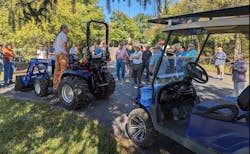Sun-Charged Golf Carts, Electric Tractors Demonstrate Mobile Microgrids for Land Managers
At Warren Wilson College’s Center for Working Lands in Swannanoa, North Carolina, students are taught to park golf carts in the sun so that the carts can charge from solar and serve as mobile microgrids – and demonstration vehicles.
The golf carts – converted from vehicles with lead acid batteries to carts charged by lithium-iron-phosphate batteries and solar – are the first stage in a larger project that aims to decarbonize land management systems and invites landowners to “kick the tires” on clean energy innovations for land management, said Dave Ellum, dean and director of the college’s Center for Working Lands.
The center demonstrates land management practices that integrate ecological benefits with economic and social returns on the 1,100-acre campus, which includes 900 acres of land to train students in forestry and agricultural management. Right now, the center uses grid power, biodiesel, gasoline and natural gas to power its operations, but it wants to begin using agrivoltaics, which is using land for both solar production and agriculture.
“We want to test and demonstrate a decarbonized land management operation. But more important than that, once we get this going, we want to open up our land operations to allow farmers and land managers to test this equipment before adopting it themselves,” said Ellum.
Students play an integral role in the projects and have helped install solar panels, he said.
Mobile microgrids can charge tools, lighting and sound systems
The golf carts, with 60 kWh of storage capacity and 15 kW of solar charging capacity, not only transport the students, staff and faculty but also can be used to charge power tools, outdoor lighting and sound systems at the center, said Keith Thomson, co-founder of the Critical Services Microgrid Group, a volunteer network of professionals and students working with the college.
Originally, the 12 campus golf carts were charged from grid power. The school planned to charge them at night at a 12-kW solar charging shed and use lead acid batteries as backup. Instead, for convenience, the school staff and students charged at grid-tied outlets located at parking spots.
The college then decided it made more sense to self-charge the vehicles with solar and batteries while parking or driving in the sun, said Thomson.
The golf carts integrate Ecobattery LiFePo4 5-kWh batteries with 340-watt solar panels and a 2.5-kW inverter. They are charged from the solar panels and can be plugged into another “mobile microgrid work vehicle” to power the other vehicle, said Thomson.
Mobile microgrids are examples of beneficial electrification
“These vehicles are microcosms of scalable solutions to beneficial electrification of buildings and vehicles,” Thomson said.
For the next phase of the decarbonization project, the college is deploying a solar microgrid to charge two recently purchased electric tractors – each costing about $49,000 – from Solectrac. Solar is now installed on the roof of a barn on campus, and the college is awaiting delivery of batteries to create the microgrid-powered charging station.
Students will learn how to operate the tractors and demonstrate them to land managers interested in purchasing them.
The 15-kW microgrid-powered electric tractor charging shed will include a 61.4-kWh battery system and two inverters, and it is expected to be completed by early 2024. It will power two fast chargers.
Part of the cost of the tractor project came from a $50,000 grant from the band Pearl Jam, said Thomson. One of the members of the Critical Services Microgrid Group has ties to the band and helped secure the grant as part of the band’s environmental and sustainability commitment. The band also funded a feasibility study to evaluate agrivoltaics at Warren Wilson College.
Funding for the decarbonization efforts also has been provided by private donors and foundations, said Ellum.
Bidirectional charging of tractors may be in the future
The college has asked Solectrac to develop bidirectional charging for the tractors, said Ellum. This would allow the tractors to charge each other and provide energy to the grid.
The college’s clean energy ambitions don’t stop with the golf cart and electric tractor projects.
Next a test of agrivoltaics
Long term, the college wants to meet its energy needs through a 1-acre, 200-kWh/year agrivoltaics installation, said Ellum.
That system will include solar panels deployed at a height above the college’s research garden. This would allow crops to grow normally with few permanent structures in the fields.
As part of a partnership with the Critical Services Microgrid Group, the installation will be used for researching crop and energy production and will be open to the public for demonstrations and workshops. The college is still looking for funding for the agrivoltaics project.
The project will look at different types of agrivoltaic setups and model what types of light would pass through them and its effect on how many crops could grow. The center will test the growth of row cops under the panels and serve as a demonstration to visiting land managers, Ellum said.
Demonstrations aim to help farmers avoid costly trial-and-error
Demonstrating innovative systems and inviting land owners to test them will help the land owners avoid costly experiments, he said.
“It’s exciting work,” said Ellum. “Who is going to take the risk of trying these things out and risking failure? The farmer can’t do it. Warren Wilson’s job is to see what works. A small farmer can’t afford to tinker around and see what works.”








